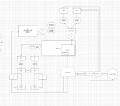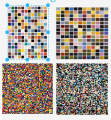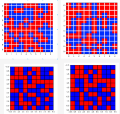No edit summary |
No edit summary |
||
| Line 10: | Line 10: | ||
'''Objective Project 23/24:''' | '''Objective Project 23/24:''' | ||
In this module, I aim to create a metaphor for the tension that can be transferred onto the individual through observing others. I want to craft an object that will either act, appear, or morph into a shape that aligns with societal expectations when observed and deforms when unseen. | In this module, I aim to create a metaphor for the tension that can be transferred onto the individual through observing others. I want to craft an object that will either act, appear, or morph into a shape that aligns with societal expectations when observed and deforms when unseen. Further, the idea is that the beauty of a unique appearance is often suppressed by the attention we receive from our peers. | ||
'''Methodology:''' | '''Methodology:''' | ||
| Line 45: | Line 45: | ||
Analogy: The placement or removal of magnets (based on observation) alters the fluid's patterns. While being watched fluid is forced into a certain shape. This mimics the idea of individuals transforming their behavior based on external pressures. | Analogy: The placement or removal of magnets (based on observation) alters the fluid's patterns. While being watched fluid is forced into a certain shape. This mimics the idea of individuals transforming their behavior based on external pressures. | ||
'''<u>Kilobots</u>''' | |||
Description: "The Kilobot is designed to make tests of collective algorithms on hundreds or thousands of robots accessible to robotics researchers." | |||
Reference: https://www.k-team.com/mobile-robotics-products/kilobot | |||
Analogy: the mentioned behavior will be simulated. The bots could act uniformly and would show unique patterns when not being watched. | |||
----<blockquote><small>[[User:Mojjo#%20ftnref1|[1]]] Sedgwick, P., & Greenwood, N. (2015). Understanding the Hawthorne effect. Bmj, 351.</small> | ----<blockquote><small>[[User:Mojjo#%20ftnref1|[1]]] Sedgwick, P., & Greenwood, N. (2015). Understanding the Hawthorne effect. Bmj, 351.</small> | ||
Revision as of 08:04, 1 November 2023
Observational effects on human behavior are significant and varied[1]. For instance, when workers are aware they're being observed, their productivity often improves. Beyond the workspace, this awareness can result in more prosocial behavior and altered personal movements, such as cutting back on food indulgences[2] and walking faster. Moreover, there's a general inclination to work towards the greater good.
The profound influence of observation on our daily conduct brings its consequences. Such awareness can push individuals into a societal mold, often rendering a unique individual into a generic persona. State-led surveillance initiatives and the concept of the "transparent citizen" intensify this effect. The expanding reach of surveillance, along with peer monitoring, makes individuals strive to fit what's deemed "acceptable" by societal standards.
This behavior isn't just seen in the broader societal context but also in intimate settings. Studies show, that already in small groups of 3-5 members, there's a felt pressure to align with norms.[3] Further familial settings offer a deeper dive into this phenomenon: children, sensing high expectations from their parents, often experience heightened stress.[4]
In conclusion, whether at the societal level or in smaller groups, external pressures often reshape individual behaviors and perceptions.
Objective Project 23/24:
In this module, I aim to create a metaphor for the tension that can be transferred onto the individual through observing others. I want to craft an object that will either act, appear, or morph into a shape that aligns with societal expectations when observed and deforms when unseen. Further, the idea is that the beauty of a unique appearance is often suppressed by the attention we receive from our peers.
Methodology:
To achieve this, I will employ a camera combined with rudimentary tracking technology. This setup will allow the object to "sense" when it's being observed.
Ideas / Materials
Dynamic Piping Structure:
Description: A pipe secured into three (?) bending machines. The central bending machine constantly and gradually alters the pipe's shape, mimicking the individual. However, when an audience looks, the outer two machines (located on the left and right) restore the pipe to its original, straight form.
Analogy: The pipe gets straightened out when observed but undergoes a transformation when it's not under scrutiny.
Electroactive Polymer Sculpture:
Description: A sculpture crafted from electroactive polymers. These are unique materials that can change their size or shape when an electrical stimulus is applied.
Reference: Electroactive Polymers: https://materiability.com/portfolio/electroactive-polymers/#&gid=5&pid=1
Analogy: The act of observation can either send or deny the electrical impulse, causing the sculpture to change its form.
Ferrofluid Display:
Description: An exhibit using Ferrofluids, liquids that display strong magnetization when exposed to a magnetic field. Introducing a magnet causes the fluid to spike, forming distinct patterns.
Reference: Ferrofluid https://tinyurl.com/3dzwhxaf
Analogy: The placement or removal of magnets (based on observation) alters the fluid's patterns. While being watched fluid is forced into a certain shape. This mimics the idea of individuals transforming their behavior based on external pressures.
Kilobots
Description: "The Kilobot is designed to make tests of collective algorithms on hundreds or thousands of robots accessible to robotics researchers."
Reference: https://www.k-team.com/mobile-robotics-products/kilobot
Analogy: the mentioned behavior will be simulated. The bots could act uniformly and would show unique patterns when not being watched.
[1] Sedgwick, P., & Greenwood, N. (2015). Understanding the Hawthorne effect. Bmj, 351.
[2] Herman, C. P., Roth, D. A., & Polivy, J. (2003). Effects of the presence of others on food intake: a normative interpretation. Psychological bulletin, 129(6), 873–886.
[3] Bales, R. F. (1950). Interaction process analysis; a method for the study of small groups.
[4] Luthar, S. S., & Becker, B. E. (2002). Privileged but pressured? A study of affluent youth. Child development, 73(5), 1593–1610.
TBA (DATA VISULASIATION)
The following is the model of a digital game, where I try to combine generative art with crypto market, where the user can interact with a protocol and the initial decision of the consumer have an impact on the generated outcome.
TBA lets you sent a fighter to most speculative battleground up to date - the crypto markets.
In the game of speculation your bot trades the coin of your choice against the dollar and against your opponents choice. May it generate wealth for you. But to succeed here is not enough, so others also must fail. Therefore after a period 101 draws in peace the automatic machines will start fighting for space on a grit of 420 spaces with 69 extra moves.
On the inspiration of industrial color card patterns Gerhard Richter painted his famous "192 Farben". The following series for "4900 Farben" could be seen as a kind of modular art work where, due to new arrangements, a randomized and unforeseeable outcome is possible, as the work "consists of 196 square elements, which in turn are composed of 25 squares each. The elements can be arranged in 11 core variations: from many smaller grid compositions of different sizes to just one large-scale work, always using all of the 196 panels."
With TBA I try to pick up the idea of a modular picture that is getting reassembled and redrawn again and again, with different outcome. Here the consumer assembles the foundation of how the picture will be drawn by choosing the strategy and the color pallet by picking the symbol. Further the outcome is visually unpredictable, even is the chosen strategy is picked thoughtfully.
As each players receive a NFT after the play is completed only the winner gets one attached with data visualization. However every address participating will be whitelisted for the "final mint " of the project. After 196 rounds each player is allowed to mint the "whole" picture, wich contains of all played rounds each randomly assembled making it 392 unique NFTs.
The code is written in Python /JS/React & Solidity more infos to resources in the final documentation.






